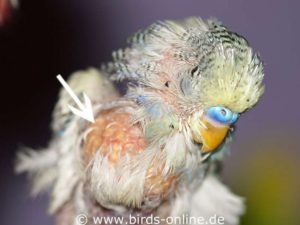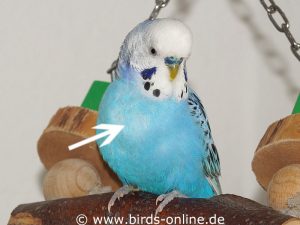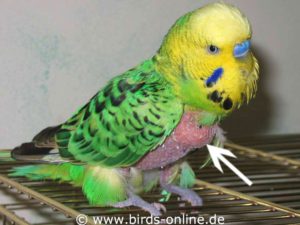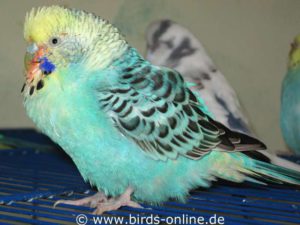Crop

The digestive tract of birds is more complex than ours. Many birds, such as budgies, have an additional part of the digestive system that is missing in humans and mammals. It’s the so-called crop, a sack-like extension of the esophagus.
A bird’s crop fulfills various purposes. Since these animals have no teeth, the food is swallowed as a whole or in coarse pieces. Inside the crop, the food is predigested with help of salivary gland-secretions and is stored for a certain time. The latter is important above all during the breeding season, but also regarding the feeding of the partner. To feed another bird, budgies regurgitate food from their crop and then give it to the partner or chick by using their beak.

Besides, the crop serves as a kind of cache, which makes it possible for the birds to still have energy available for some time after the actual food-intake. Their crop enables them to consume large amounts of food within a short time. This is especially important for the wild budgies in Australia who usually feed on the ground. While doing so, they’re constantly in danger of being captured by a predator. Therefore, the birds eat fast and as much as they can. Then they fly away and digest the food stored in the crop later at a safe place.
This time-delayed absorption of the energy from the food is essential for budgies because they have a high energy requirement to survive. Therefore, they react sensitively to starvation phases. Provided that they find enough food, their crop enables them to survive for several hours without eating – for example during the night. For this reason, wild budgies not only eat in the morning. They consume a further portion of food in the late afternoon or shortly before sunset. This food is gradually digested in the late evening and during the night.

The inner surface of the crop is covered with a rather sensitive mucous membrane. It can easily be damaged for example by swallowed plastic pieces (from broken toys) or splinters of wood. Bacteria, viruses, fungi, and single-celled organisms (parasites) can lead to an illness of the crop – the so-called sour crop or crop infection. It should always be treated by an experienced avian vet.
To determine which pathogens are causing the health issues in the individual case, further examinations (smears, laboratory tests) should be carried out. Only by doing so, a crop infection can be treated in a goal-oriented way. If such a disease is not treated at all, it can quickly lead to the death of the affected bird because the animal will starve. This happens very fast: Just two days without food consumption can be life-threatening for a budgie.
What does a swollen crop mean?
Compared to other birds, budgies have a fairly large crop. It is quite stretchy, which is well recognizable particularly in budgie chicks or in birds who are lacking the feathers at their breast. In an adult, healthy, and fully feathered bird, the crop is normally covered by the plumage. One recognizes it as a slight bulge if a bird has just eaten some food beforehand.
Sometimes, birds eat such large quantities that the crop is filled to the brim. That can for example happen while the birds are raising their young. Nevertheless, the bulge caused by the food looks harmonious and smooth. If, on the other hand, the crop is heavily swollen and protrudes with distinct edges from the silhouette of a bird, this could indicate a disease such as a bacterial infection.


